Boss DM-101 Analog Delay Pedal – Now Cheaper & a Review
Guitar and Synthesizer Effects Pedal
[10 January 2025] This great analogue delay pedal is now available at a reduced price. After its release, the pedal cost €519.00 – now the price has been reduced to €392.00. That’s what we call a deal!
All About Boss DM-101
Boss Delay Pedal – Now Even Cheaper!
Here at Thomann* you can now buy the Boss DM-101 for $339.00 / £329.00 / 392.00€. Unfortunately we can’t say how long this offer will last or if this is the new regular price. If you’ve always been interested in this effect, now is definitely a good time to get it.

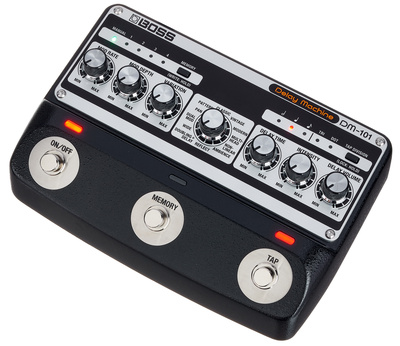
Boss DM-101 – Review
[21 July 2023] We already wrote about the newly introduced Boss DM-101. After some begging and pleading, I was lucky enough to get the opportunity to test the new analog delay extensively in my home studio. Here’s why bucket brigades and multi-heads are awesome.
Boss DM-101 in a Nutshell
- Fully analog delay pedal with digital control
- 12 delay modes (6 mono, 6 stereo)
- MIDI control via mini TRS
- Intuitive design with cool retro vibes
- Tap tempo
- Carryover for lossless signal transmission
- The best and most musical (analog) delay sounds in a long time
Design and Workmanship
Boss has long been known for the stage-proof, indestructible design of their effects units. The DM-101 is no exception: A solid metal chassis with black, textured paint and a sturdy metal base plate form the basis. The six knobs provide good haptic feedback and are sensitive enough for the tiniest adjustments.
The modes are selected using the rotary switch in the middle, which snaps pleasantly into place when the desired delay mode has been set. If anything, the buttons for tap division and memory come across a bit flimsy.
Fortunately, Boss resisted the urge to use more LEDs than necessary. While some other pedals are covered in distracting, blinking lights, the DM-101 limits itself to the most important information. The red glow is pleasantly subtle, even in dim light. Very nice.
Boss DM-101: Technical Features
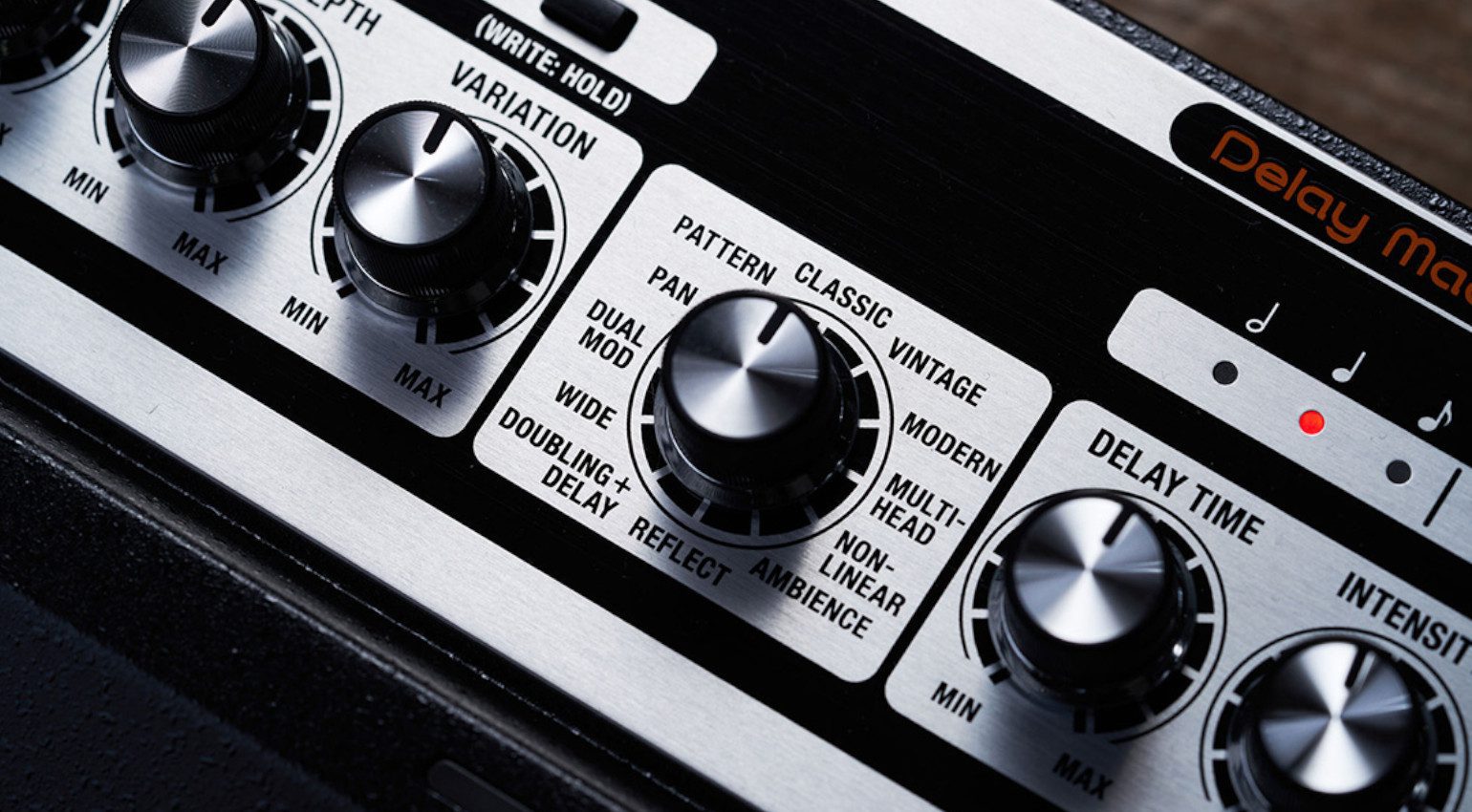
As an analog delay pedal with digital control, the DM-101 seeks to combine the best of both worlds. Moreover, it’s packed with features and possibilities. All connections are located on the back of the unit. That’s especially convenient if space is at a premium on the pedalboard.
Next to the 1/4″ input, you’ll find two outputs: A/Mono and B, the latter of which is used for the stereo delay modes. The option to plug in an external footswitch or an expression pedal is a nice extra. The small USB input seems a bit out of place, especially considering the analog approach of the pedal. Finally, there’s a pair of mini TRS jacks for MIDI In and Out, to which you can connect a controller – more on that later.
In addition to the power supply, the Boss DM-101 comes with four rubber feet, which ensure that it stays securely in place. But no more beating around the bush – let’s check out how it sounds.
How Does it Sound – Testing the Boss DM-101
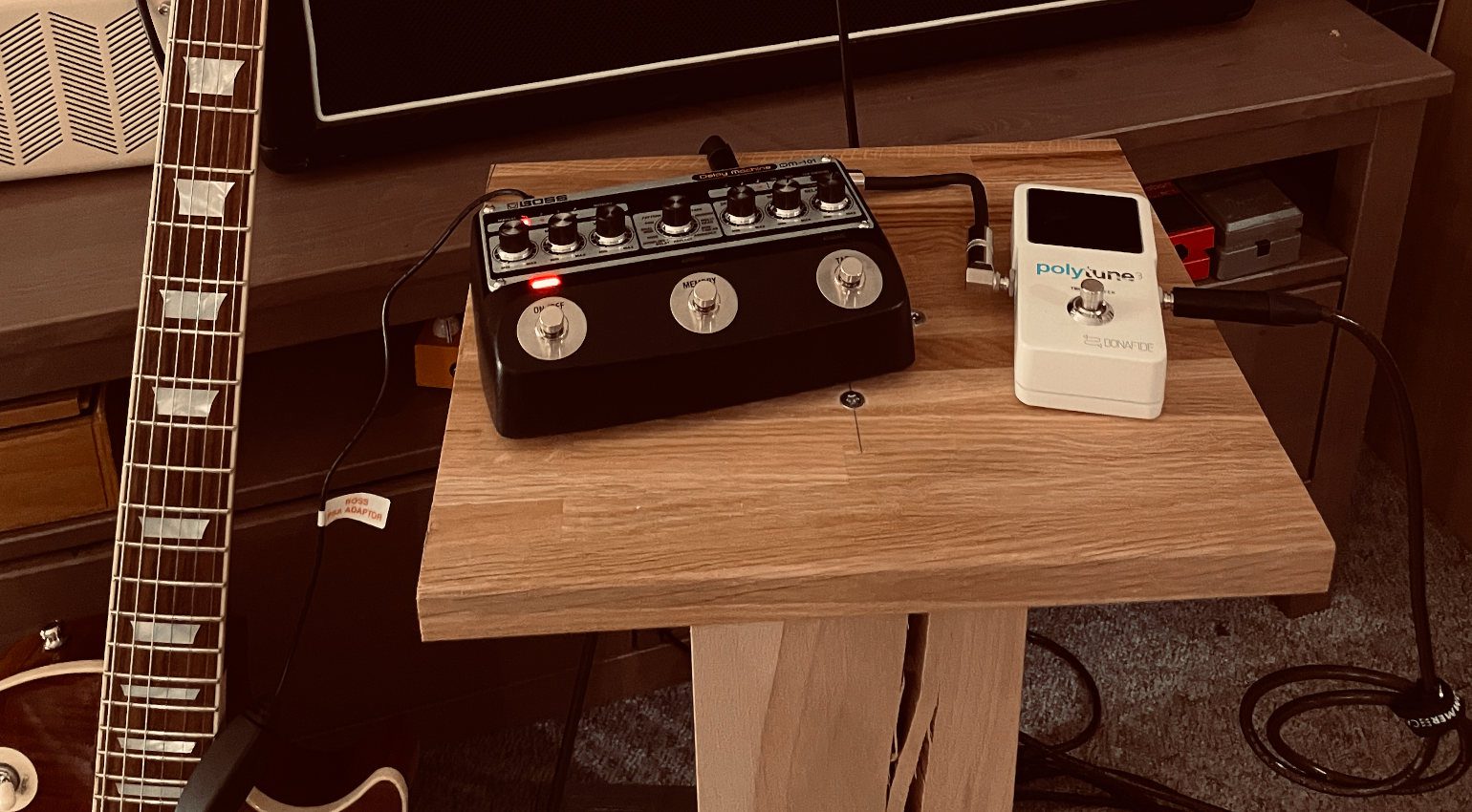
I tested the Boss DM-101 with two completely different setups:
On the one hand, I tried the delay in front of my Laney Lionheart L5 using a Maybach Lester ’59. The only other pedal was a tc electronics Polytune 3. The amp runs through a 2×12″ cabinet with two Celestion G12M Greenbacks.
In contrast to this very, very analog setup, I decided to also try the Boss DM-101 alongside my TONEX pedal. Analog meets digital, so to speak. In this case, the guitars are a Telecaster with the awesome Gristle Tone pickups and a Gibson Les Paul Custom Lite.
Soundcheck – Setup No. 1
Thanks to their use of BBDs (bucket brigade devices), analog delays are very warm and rich-sounding effects that are more on the dark side of the spectrum. The analog chips don’t reproduce the high frequencies and harmonics as cleanly as modern digital delays – a definite plus in my book.
Combined with a small, highly expressive all-tube amp like the Laney L5, this characteristic really comes into its own.
I tested my way through the mono section of the DM-101, beginning with Classic mode. The warm, very traditional sound is super varied and can be maxed out with up to 1200 ms of delay time. Too much for everything I have in mind, but still an invitation to dive into the world of spherical sounds.
Highlight: The Multi-Head Mode of the Boss DM-101
I’ll skip the Vintage and Modern modes, as their more modern delay sounds don’t really catch on with me – too treble-heavy for my ears, which are now accustomed to analog warmth. On the other hand, the multi-head mode really makes the sun shine.
This very successful interpretation of a tape delay is insanely musical and gives me exactly what I was looking for. Playing some dotted-eights riffs, I was blown away by the complexity of the sound. The ability to use the Variation knob to choose between ten different head combinations is the icing on the cake. Hats off, this sound really rocks.
The next mode, Non-Linear, is a cascade of delays that increases in volume. Too complex for me personally, but definitely convincing if that’s your thing.
Stereo Shenanigans
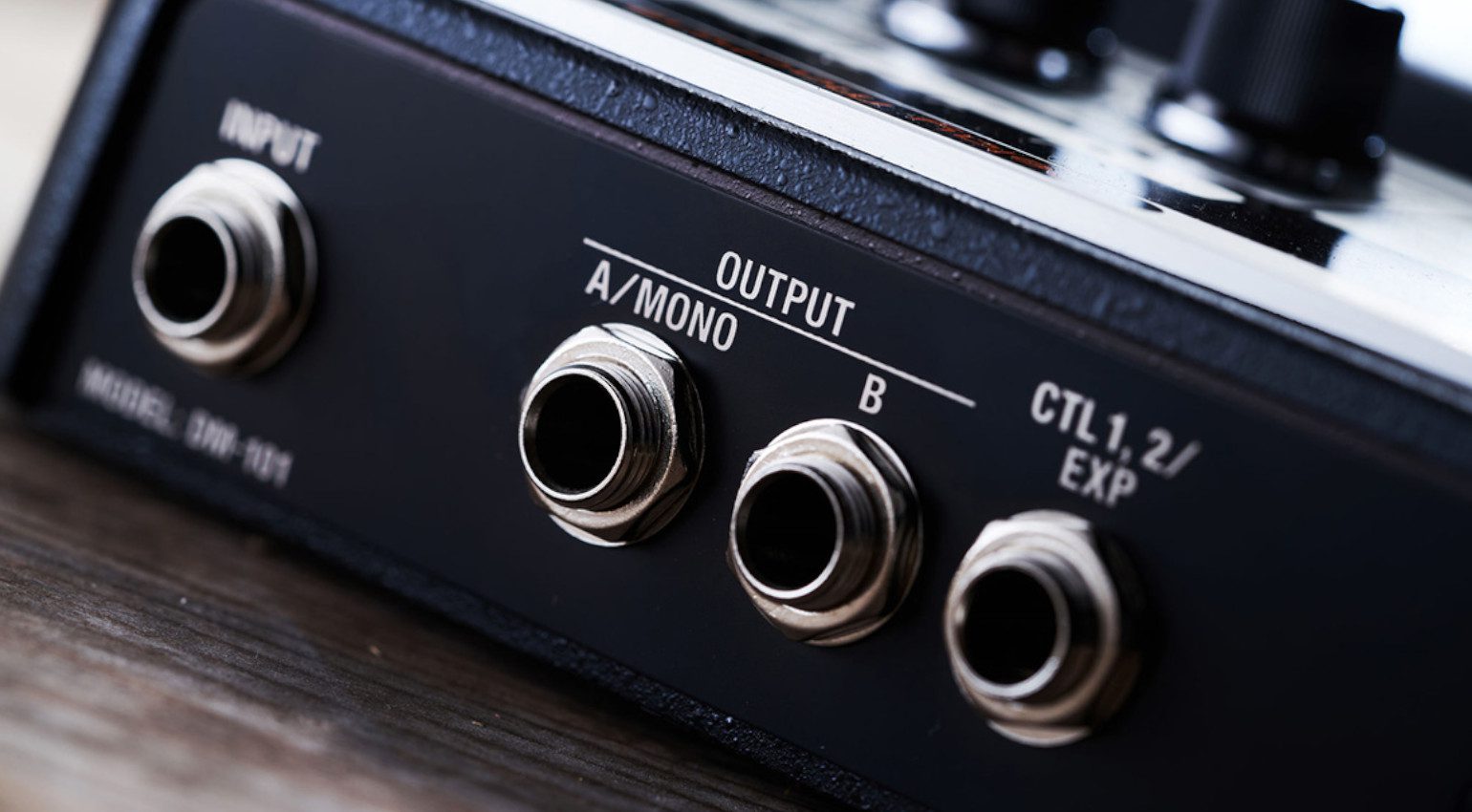
This is the end of the mono world. And my mono test setup is obsolete, at least in parts. So I switched to a nice AC30 clone and wired up a quick stereo setup.
This works well, albeit with a drawback. Despite the fact that the Boss DM-101 offers a couple of excellent stereo modes, it lacks a stereo input. Want to use a stereo chorus in front of it? Well, you’re out of luck. Beyond the guitar world, this will also be a significant disadvantage for synth players, for example. It’s a real pity – in the $500 price range, I would have appreciated having complete creative freedom.
Stereo Sounds
Starting with the Reflect setting, the wide stereo stage immediately opens up, supported by a subdued, very spatial reverb component in the sound.
The Doubling+Delay mode requires some careful knob twiddling: The combination of a doubled sound with a longer delay must be carefully tuned using the Variation control to prevent sonic aberrations.
Let’s move on to Wide mode, which turned out to be one of my favorites. Variation almost at 0, Delay Time at 12 o’clock, Intensity at 3, and Volume at 12 yields a wonderfully wide stereo image. Loads of fun, despite my impromptu stereo setup, which was semi-professional at best.
Finally, I dove into “sound painting” with Dual Mod mode – not exactly my way of playing guitar. But the sound is seriously whacky and allows for many unique effects, especially with a slightly distorted basic sound. Pan and Pattern once again gave me that U2 feeling, when the Maybach fired up the tubes a bit hotter.
Soundcheck Boss DM-101 – Setup No. 2
Don’t worry, I’m not going to repeat this whole process with a digital Tonex amp profile. I just felt obliged to try the Boss DM-101 with my regular setup I use on a daily basis.
Feeling most at home in harder musical realms, I couldn’t help but fire up a couple of Soldano, Friedman, and Diesel clones with the Boss DM-101. And what can I say – the Boss delay didn’t disappoint. Especially in faster passages with palm mutes, the various modes delivered a very organic, open sound that never lost its analog touch (even in this purely digital setup). It’s great how a few analog BBDs can turn a simple delay into something really special.
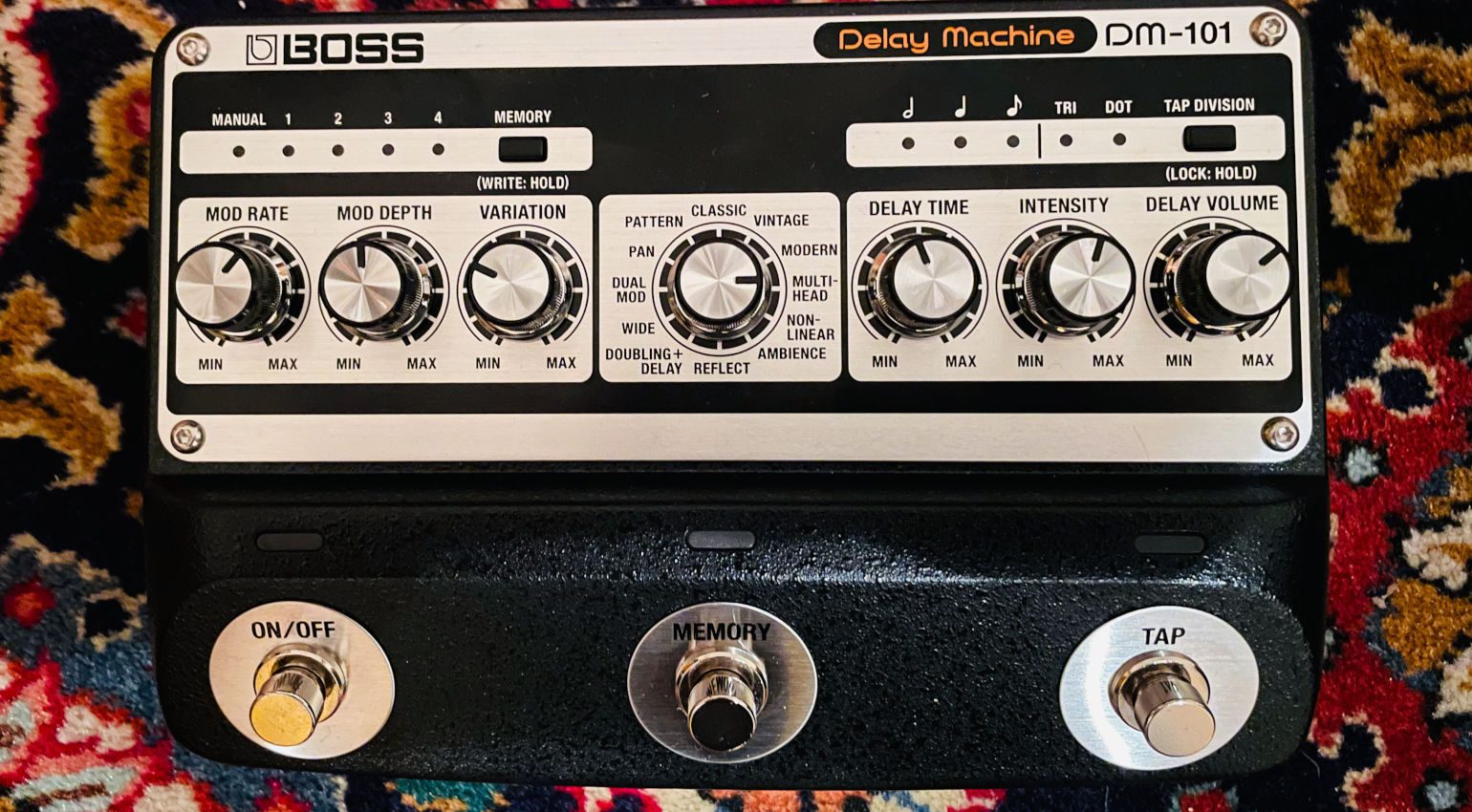
Analog Delays Cost Money
Let’s get down to business. The price of the DM-101 is squarely in the $500 region. Considering its one major flaw – the missing stereo input –, you might even have doubts if the investment is worth it.
But here’s the thing: A fully analog delay will always cost a good deal more than its digital counterpart. In addition, the DM-101 delivers a whole range of features and sounds that make it stand out from the crowd.
The list of features is also quite remarkable. The memory function, for example, allows you to store up to 128 presets of your own, which can be recalled with an optional MIDI controller. I think not even David Gilmour uses this many different delays.
Boss has stuffed all of this into a high-quality and truly unique-sounding pedal that’ll survive even the toughest conditions on stage. Yes, the price is high, but the quality is even higher.
Conclusion: Boss DM-101
I thoroughly enjoyed my time with the Boss DM-101. Personally, I mainly grew up with digital delays and only had a vague idea of what I’d been missing. The opportunities to immerse myself in a truly high-quality, fully analog setup were few and far between.
I’d like to point out one thing, though: a pedal like the DM-101 can only really shine if you truly know its ins and outs. Nothing would be more tragic than keeping it on a fixed setting. OK, I’ll make an exception for the multi-head setting.
Once you really get to know it, the Boss DM-101 delivers exactly what it promises: authentic, well-rounded, and, above all, highly musical delay sounds.
The Boss DM-101 Delay Machine is available at Thomann*.


Boss DM-101 Delay Machine: Pros and Cons
Pros
- Fully analog delay pedal with digital control
- 12 delay modes (6 mono, 6 stereo)
- MIDI control via mini TRS
- Intuitive design with cool retro charm
- Tap tempo
- Carryover for lossless signal transmission
- The best and most musical (analog) delay sounds in a long time
Cons
- Relatively high price
- No stereo input
More About the Boss DM-101
Note: This article by Jan Rotring was originally published in German on gearnews.de.
*This post contains affiliate links and/or widgets. When you buy a product via our affiliate partner, we receive a small commission that helps support what we do. Don’t worry, you pay the same price. Thanks for your support!
One response to “Boss DM-101 Analog Delay Pedal – Now Cheaper & a Review”

 4,3 / 5,0 |
4,3 / 5,0 | 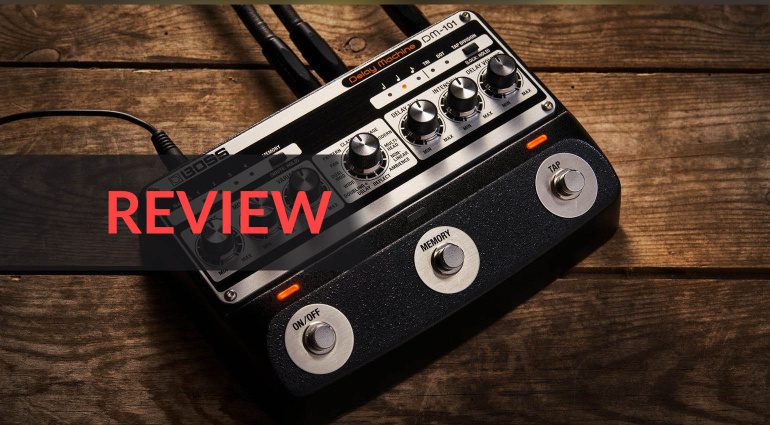


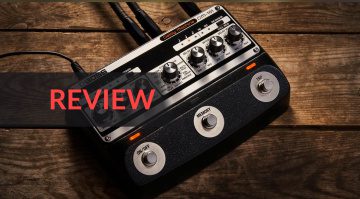

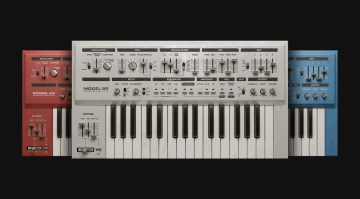
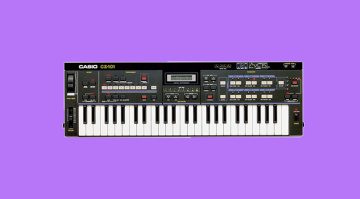
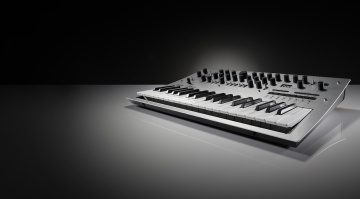
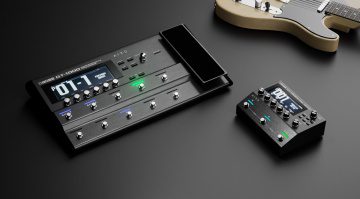

I bought it yesterday for 329 at a Dutch webshop 🙂